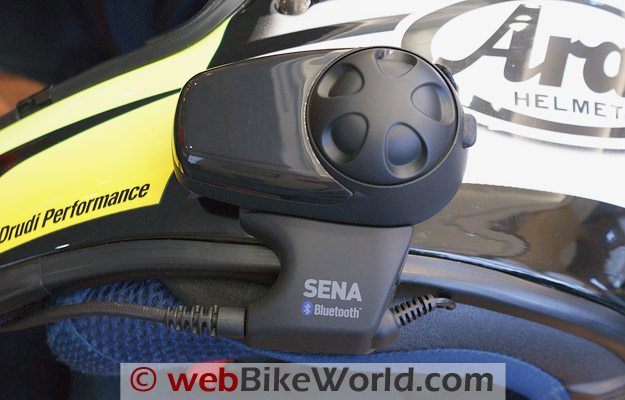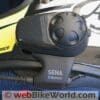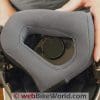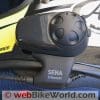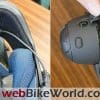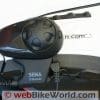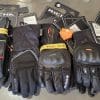Wow! This is the current intercom system to beat.
While I could debate whether this is a “Gen 3” or “Gen 4” motorcycle communications system, I cannot and will not argue that the Sena SMH10 Motorcycle Bluetooth Headset and Intercom system (review) is THE real thing.
So with most of the essential good stuff covered very well under Part One but without letting any of it bias me…it is time to let you know how the Sena systems perform in the field.
Communication and coordination is a great thing.
So it came to pass that I was in Virginia seeking an early spring (in reality it was actually occurring north of the border already) and via an overnight shipping effort the Editor had all four Sena units delivered into my hands, shortly after the F800s had been unloaded.
The plan comes together.
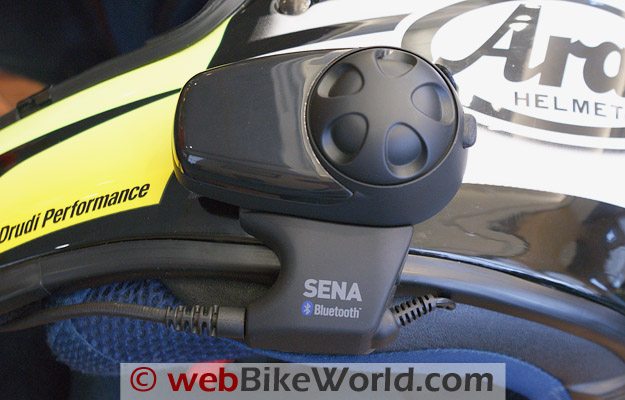
Helmet Installation
With all four units charged up via the USB-ported AC chargers and in preparation for daily road use, two of the systems were mounted on an Arai XD3 (review) and Arai XD (review) respectively and the other two systems got installed on the Nolan N103 (review) helmets.
The clamp brackets fit well on the Arai full face helmets and it takes less than five minutes to slip the bracket inside the bottom edge of the helmet, position the bracket so that the boom microphone is centered in the chin piece and, secure the assembly using the supplied 2.5 mm Allen key to tighten up the two small pinch bolts.
The boom with microphone measures 18 cm or 7.0 in and as such allows a fair bit of latitude in where the bracket can be mounted on the left side of the helmet. Some users prefer the Bluetooth module to be located forward on the helmet, while some prefer it on the outside point or slightly to the rear, typically for ease of access and so as to not interfere with any outer garment.
There are actually two good orientation indicators on the boom microphone, one more tangible than the other. The small triangular indent on the plastic casing indicates the mouth or input side, but it is the raised edge on the helmet side of the casing that makes confirming orientation so easy.
Time was taken to feed the headset speaker leads between the cheek-liner and neck-piece components of the helmets for a tidier and secure installation. From this point it was an easy matter to run the left and right speakers into their respective cheek moldings.
The Sena speakers have the ‘hook’ side mounted on the back and with ‘loop’ rounds already mounted in the helmets getting, the speakers aligned with the ear and secured in place takes only another minute or so.
Depending on the helmet, shape and depth of the ear cavities and the user, the speakers may need to be adjusted slightly or even moved closer to the ear. For comparison, the Scala Rider G4 speakers measure 35 mm in diameter and are 2.5 mm thick, while the Sena SMH10 speakers are 40 mm in diameter and 6 mm thick.
As interior differences vary widely between helmet brands and even brand models, initial fitment and audio testing is time well spent. This effort typically results in a better audio environment that provides other efficiencies, especially regarding volume and clarity.
Having used and evaluated a fair number of motorcycle communications systems, I have to give the integrated Sena assembly top marks for design, quality, execution and fit.
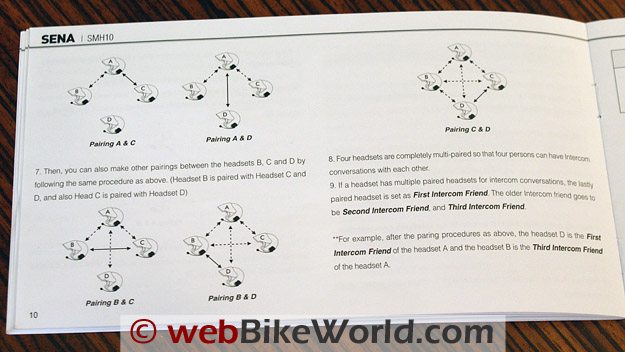
Peripheral Pairings
The system is easy to setup, configure and use – with virtually anything. But I have a number of different devices on hand for use, some aging gracefully and besides, I can usually break anything.
First up was the Garmin zumo 660 (review), but it wasn’t much of a challenge: put the Sena into pairing mode by pressing the Phone button for five seconds, wait for the Red/Blue LED flashing sequence and, initiate a new device search on the zumo. Within two seconds the devices had found each other.
After accepting the ‘SMH10’ device listed on the zumo’s display and waiting another two or three seconds, a confirmatory beep is heard in the headset. With this positive sign, activating the media player on the zumo results in an immediate and most excellent stereo stream pushed to the headset via the Bluetooth module receiver.
Pairing another Sena system mounted on one of the Arai XD helmets provides the same result. In this multi-system environment, the zumo drops the first (ongoing) connection and picks up the most recent (last) device paired. Changing the target or receiving headset is done by highlighting the desired receiver and touching ‘OK’, although I found it didn’t always work well…
The older and sometimes wiser BMW Navigator III+ actually beat me to the draw. I had left its Bluetooth on and in Automatic Pairing mode…within a heartbeat or two of putting the Sena into pairing mode the two were shaking hands and after accepting the on-screen pairing, the two began communicating in the desired manner.
The HTC Touch devices are typically a crap shoot of sorts but for a change results were positive. Fail-proof actually describes the results in pairing the HTC devices with any of the Sena systems: with both ‘Stereo Headset’ and ‘Handsfree’ enabled, the onboard MP3 player rocked the Nolan helmet and calls could be received, initiated and terminated.
But when it came time to set up a three-way test configuration with the zumo 660 hosting a mobile phone, the Sena headset – zumo – HTC configuration proved a bit frustrating. With the zumo’s navigation guidance or media player active, initiating or answering calls goes well, but once a call is terminated or rejected, things go awry.
In almost every instance navigation or media streaming resumes but in an on-off cyclical and choppy manner, which seems to indicate that something else is using or reserving bandwidth and time. The HTC was the only device hosted by the zumo to exhibit this issue.
I made some profile configuration changes to the HTC but the condition persists. Resetting the pairing via the zumo, or refreshing the profile connection via the HTC resolves the issue but only until the next call sequence. This issue is being investigated.
So far the Sena has paired with and received audio from four Bluetooth Adapters: AKE BTD-302 Audio Adapter; the Chatterbox iCombi AG-12 Bluetooth Adapter; the Camos BH-200M Bluetooth Adapter (stereo and mono); and the diminutive Rocket Fish MBT30 (not reviewed).
The multi-function HTC Touch and Kyocera X-tc devices along with the more basic LG5500, LG LX165 and Motorola i335 mobile phone units interface flawlessly.
With every system condition indicated by an LED sequence and audio tones, it is simple matter to power the system on and off or initiate device or intercom pairing modes while wearing a helmet so equipped.
Pairing mode persists for 120 seconds, after which the system reverts back to standby mode indicated by the Blue LED cycling every three seconds. Unlike other systems however there does not seem to be a way to interrupt pairing mode once initiated, outside of turning the system off.
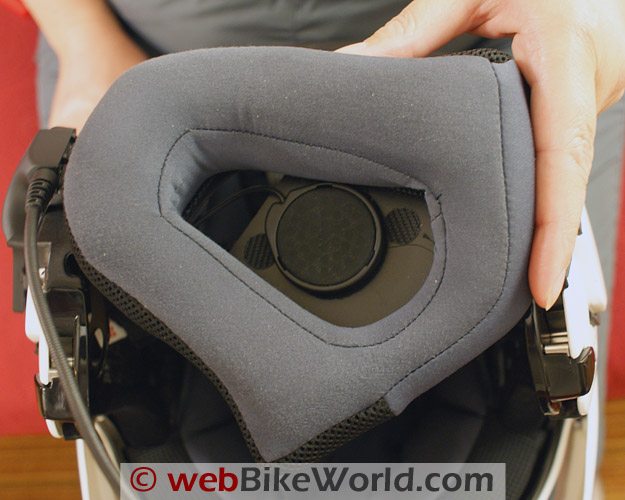
An Audio High
Acknowledging the audio assessment made in the First Look, my own critical assessment after over a month of heavy use is the same: outstanding. The large and heavy speakers do a great job. I don’t know the specific frequency range that the speakers are capable of, but to the ears of everyone who has tried them, they are very much hi-fi quality.
A specific and very effective example is the difference in sound between the Arai XD and Nolan N-103 helmets. The Arai helmets are quieter and the speakers work well in them with minimal volume settings, but the crystal clear audio is devoid of much tone.
On the other hand, with these speakers and Nolan’s effective audio chamber created inside the N-103 helmet, the sound experienced is close to the AKE High-Sound headsets that have been my ‘lab’ standard for quite some time. It is entirely possible to discern minor changes or discrepancies in audio tracks.
Does the helmet headset provide external headset or in-ear quality? Not quite, but close. Just remember not to let that hi-fi audio distract you from the primary function — riding the motorcycle safely, including being aware of the surrounding environment and observing regulations regarding device use.
Real Deal Road Use
Intercom Communication Distance: All four Sena SMH10 intercom units are in use as we rotate the Arai and Nolan helmets, depending on what the rider feels like wearing and the type of ride planned. This provides a great ongoing evaluation environment and mixing in a variety of peripherals adds even more flavour.
Riding through typical western Virginia flat-to-mountainous terrain with lots of elevation changes, curves and switchbacks, through to the gentler but still rolling terrain of the Ottawa Valley and Highland regions, intercom range averages 750 to 1000 metres.
Yes, that’s right — a full kilometre or well over on-half mile (0.62 mi). On more than one occasion this separation was exceeded for periods of time albeit when it was clear sailing on nice flat terrain like an Interstate or one of the major 400-series highways here north of the border.
Weather conditions have very little impact and signal degradation is minimal even at extended distances. It takes a really dense urban environment, steep hills or multiple switchbacks to get the effective range to drop below 500 metres (546 yards or 0.31 mi).
Traversing mountain passes between Virginia and West Virginia really shows how reliable the link is, with contact maintained even though the systems were separated by two or more switchbacks.
The minimum link ranges experienced with the Sena units are still well above optimum or maximum ranges obtained from many other systems under similar or lesser conditions.
When the link weakens, noise levels increase and audio becomes scratchy, but with the Sena systems that is usually just before the link drops out. When the link is lost, the system attempts restoral every eight seconds, indicated by two high-tone beeps. So far recovery of an interrupted link has never been an issue.
Audio Quality: Intercom clarity also rates an outstanding; it equals anything I have experienced even when using high-power FM transceivers . Audio is crisp and clear and the automatic gain control does a good job of keeping audio levels constant as external noise levels change.
If a quick adjustment is needed it simply involves a quick turn Up (clockwise or to the rear) or Down (the other way) of the massive and easy-to-find Jog Dial
The helmet environment behind the BMW Touring Screen on the F800GS is good with the noisy Arai XD top air vents or gusting side winds being the biggest intrusions. But even with these distractions we were able to speak softly, typically just above a whisper, and still be completely understood by the other users — impressive.
While the Nolan N-103 helmets provide a far superior music listening environment they are themselves noisier than the Arai helmets and on occasion, even with the audio gain control doing its job, manual volume adjustments via the Jog Dial were needed, especially when short but frequent wind gusts were experienced.
The major plus here is that the units have lots of volume. Depending on the input source it can get intense before the audio maximum warning tone is heard. A quick crank or two of the Jog Dial to the rear while listening to a high output audio device will prove the point; forewarned is forearmed.
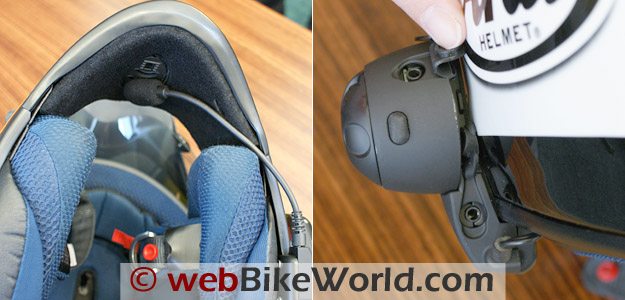
Multiple Intercom Connections
Multi-system, multi-pair mode operations are a breeze. All four Sena units can be distributed and used in virtually any combination desired…one just needs to keep track of the respective pairings done and the “Last In First Out” (LIFO) principle involved in connecting any two together as a temporary link.
Operational distances remain on par with that experienced between two users which effectively means that when spread out, a serial-communications chain (A – B – C – D) can be maintained over extended distances.
Alternatively, in group rides, the designated riders can provide essential communications from lead to tail and points in between, something really useful with large escorted groups where getting split up is or can be a fact of life.
For off-road events, three or four units will provide essential communications between trail or course functionaries.
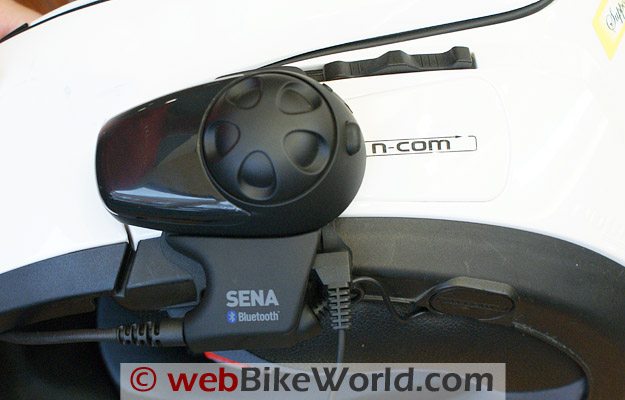
Some Observations
The supplied adhesive mounting plates got used for the Nolan N-103 helmets. They only managed to secure the units for two days, with one unit coming off after the first day of use, in the middle of a ride. No damage or risk thankfully, but it was not expected.
Not all of the blame can be attributed to the thin 3M adhesive material used. The Nolan shell is very hard and very smooth and it has a soft plastic bottom edge, both of which provide challenges except for very hardy adhesives, a fact learned from experience.
Coming back to the adhesive used, if the pad was thicker (more cushioning) and used a stronger adhesive, the mount would provide better surface conformity and better adhesion on surfaces. As used in the past, some Superlock Strips (Radio Shack PN 64-2360) cut to emulate the original adhesive pattern is working well under daily use.
And on to another personal peeve: system versatility could be enhanced if the bracket and headset assembly were modular rather than one piece. I prefer the modular approach as it allows components to be repaired, replaced or upgraded.
A modular approach facilitates addition of a (supplied) or optional adapter for an in-ear headset, something that many of us prefer to use full or part-time. Most wired systems provide an in-ear option, as do some of the wireless systems like the Camo BTS-300 units that uses the modular in-ear BHC-10 adapter to provide an in-ear option.
Mac Incompatibility
Note that as of February 2012, the SMH10 firmware updating software is not compatible with Apple Macintosh computers.
Here’s a note from “K.W.” in Atlanta on this issue: “I just received the SMH10 to go with my new BMW K 1600 GTL. It’s the ear buds option that made my decision.
The issue people need to be aware of is that this device can’t be updated using an Apple Mac computer. The service department just sent me an email that I’d have to return it to them for the firmware update. I ask for them to send me an updated device with return postage to send the unused item back but they said no. That would leave me without a device I’ve paid for while they make the updates.
This is an FYI as I was about to do a review on the SMH10 along with my BMW K 1600 GTL review. Since I’m a supporter of your site I wanted you to be aware of this issue.”
The Bottom Line
| 2010 Sena SMH10 Bluetooth Intercom Bottom Line Ratings | ||
|---|---|---|
| Feature | Rating | Comments |
| Packaging | Excellent | Simple packaging, the system is laid out in the top eggshell and everything else is neatly bagged and packaged in two small cardboard boxes as the second layer. |
| Design | Excellent | Larger than usual integrated headset component, but its styling and smooth edges are visually attractive and nothing ‘sticks’ out. |
| Execution | Excellent to Outstanding | Everything exudes quality and strength and pieces are well finished. The detractor, at least for me, is the one-piece headset component.It would be great to see a modular assembly that facilitates repair/replacement or use of optional pieces. The microphone boom appears lightweight, but remains pliant and connected after prolonged heavy use. |
| Features and Performance | Outstanding | Whether this is a Gen 3 or Gen 4 motorcycle communications systems is debatable, but there is no argument that the Sena SMH10 is the most advanced and most capable Bluetooth-based system that I have evaluated so far. |
| Intercom | Outstanding | The SMH10 has the versatility, clarity and range that I have been hoping for and now have. Being able to configure up to four users and switch between them with one, two or three quick pushes of the Jog Dial is something that riders, organized groups or support teams will be able to exploit fully. |
| Multi-User Configuration | Outstanding | Up to four systems can be ‘networked’ to provide multiple set pairings and switching.The SMH10 network is based on the last-in, first-out or LIFO principle, meaning that the last system paired with ‘A’ will only take one tap to connect, etc.
The Bluetooth one-to-one principle still applies, but in a multi-user environment, the ability to ‘pair’ the devices in almost any order. The ability to pair devices in almost any order provides great flexibility. Sena makes this limitation quite transparent. |
| Audio Input & Control | Outstanding | Wireless audio is provided via the Headset, Hands-Free and A2DP profiles, with AVRCP allowing remote control of compatible AV peripherals.A wired 3.5 mm stereo input port is also available on the back of the headset assembly base. As a wireless profile, AVRCP is not available for wired peripherals. |
| Audio Sharing | Not Available | Outside of the full-duplex intercom capability, no other audio sharing (via discrete channels or broadcasting) is provided, which is a real shame.Even though each system module can have their own wireless or wired devices, the ability to share a common audio stream (separate from the intercom) between a rider and passenger is an attractive option. |
| Device Compatibility | Outstanding | Outside of two legacy and obviously proprietary Bluetooth adapters I tried, the Sena system has paired and worked with everything offered up.Based on device compatibility, advanced mobile phone voice functions are supported as well as remote control (AVRCP) media player functions.
Sensing, pairing and device switching is extremely fast. |
| Options | N/A | The battery is non-removable and the unit can be operated and charged via the auxiliary (cigarette lighter) connection while riding. The SMH10 does not support use of a personal in-ear headset; requests from riders for these features or options are becoming louder and I am confident that industry will respond. |
| Fit | Excellent | The mounting bracket is quite large, largely due to the extended base that houses the microphone boom and audio input port, so the assembly sits a bit lower than I like. But it wasn’t really a bother even when wearing high-neck garments.Its fitment to a variety of different helmets was just about perfect overall. The speaker wires are long enough and the speakers, larger than many others on the market and heavyweight, are easy to install.
I prefer a component headset assembly where the microphone and speakers can be disconnected for installation or replacement but other than this personal preference, it is hard to fault the SMH10 headset. The adhesive mounting option is the weakest component. Some systems provide an adhesive or ‘permanent’ mounting solution that is an obvious after-thought while on the other hand, other systems provide an adhesive mount that is clearly designed and tested to the same standards as any other option, i.e., a clamp mount. |
| Setup and Configuration | Outstanding | All of us have pushed the ‘Easy Button’ for this category. Reading the Guide once, then for a second time with the system in hand and trying everything dynamically will likely be all that is required to get comfortable with the SMH10.Everything worked the first time and only in the case of certain peripherals that are always cranky to work with did a second attempt need to be undertaken to get devices paired up and working with each other.
The latest Bluetooth version implementations make life a lot easier when working with newer generation devices. In most cases, auto-negotiation and security is taken care of automatically with little or no user intervention required. And while this hands-off approach raises some concerns, for the vast majority of users it is appreciated. |
| Ease of Use | Outstanding | Plug it in to an AC or DC source and charge it, snap it onto the bracket and press both controls to instantly turn the system on or off. The Jog Dial and Phone buttons take care of it all, sometimes singularly and sometimes together.Once the various functions have been used two or three times, it becomes intuitive, even on the road. A big contributor in simplifying a somewhat complex system is the use of audio tones for every input or system condition and even though the tonal series might seem complex, it’s not.
Being able to do everything with the helmet and system mounted is, at least for me, very agreeable. |
| Power | Excellent | This category takes a slight hit due to the fact that the battery is internal and non-removable, even though it is good for ‘hundreds of charges’.Even with the intercom activated, over eight hours of use possible on one charge. In a mixed use environment, with pretty heavy intercom and audio use, a single charge still provides over six hours of use.
When the battery does begin to run down, a gentle low power audio alarm will be heard. Recharging typically took 60 to 90 minutes from an AC source and almost twice as long via a personal computer USB trickle charge. Adapter output is 5V at a nominal 1.0A. The modular switched AC adapter features changeable country-specific adapters (NA plug supplied) and a USB to coaxial power connector. The cigarette adapter terminates in a coaxial power connector. The auxiliary electrical adapter allows the Sena system to be charged up via a NA cigarette lighter outlet. By using a Powerlet/BMW accessory power adapter, the systems can be powered and recharging while riding. |
| Reliability | Excellent to Outstanding | I’m reserving some space here for the long term side of things, but so far the Sena systems have been stone reliable and nothing has failed, less the original adhesive mounting panels. Intercom link reliability is outstanding. |
| Maintenance and Support | Excellent | Outside of creating custom adhesive mounts to replace the failed kit units, nothing other than periodic charging, unless the adapter is used, has been required. I know the Editor has gotten timely feedback and support from the Sena representative as well. |
| Cost | Outstanding | At a list price of $219.00 USD for a single sytem and $399.00 for a DualPack, don’t walk, but run to your keyboard to order them! For a new generation system that has simple but ultra functional features, the Sena SMH10 helmet system is a steal! |
| Value | Outstanding | The SMH10 is a well-balanced blend between design, features, execution and performance, with full stress on performance.It doesn’t have every bell-and-whistle I could hope for, but since receiving them and with some serious reflection on the state of Bluetooth systems, they represent tremendous value. |
Other Factors
- Certifications: Not-Rated.
- FCC Compliance Statement: Compliant with Part 15 of the FCC Rules.
- RF: The FCC RF Exposure Statement is contained in the Certification and Safety Approvals section of the User Guide along with the other disclaimers. It is important that consumers understand the implications of using radio frequency devices for personal communication purposes.
- CE Declaration of Conformity: CE marked and declared compliant with Directive 1999/5/EC.
- Bluetooth: Compliant with and adopts Bluetooth Specification 2.0.
- Ruggedization: Not certified to a formal (IP) standard but built to be “weatherproof”.
Conclusion
With two riders, multiple motorcycles and multiple helmets, the portability provided by stand-alone Bluetooth systems is hard to beat.
Appreciating everything provided by the many systems on the market, my key requirement is still communications. In this regard, the Sena SMH10 system is outstanding.
Outside of the weak adhesive mounting plate, anything else is extreme nitpicking.
So what does this mean? The SMH10 system is my new champion. Even with the Cardo G4 units now in hand, and the F4 Interphone systems headed my way, the Sena system raises the bar to a new height.
More: Sena SMH10 Review (Part I)
Also: Motorcycle Bluetooth Intercom Page | Motorcycle Intercom Page | wBW Reviews Home
Owner Comments and Feedback
See details on submitting comments.
See the Sena SMH10 Review (Part I) for More Owner Comments and Feedback.


